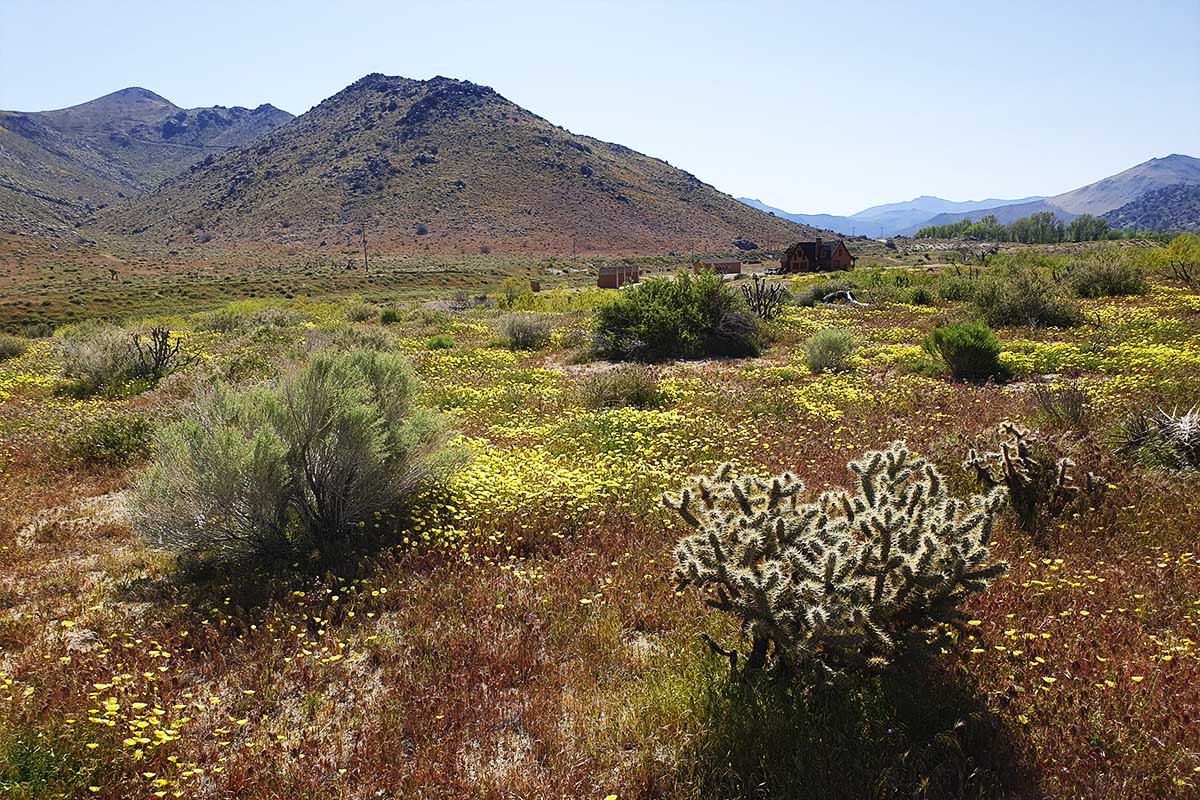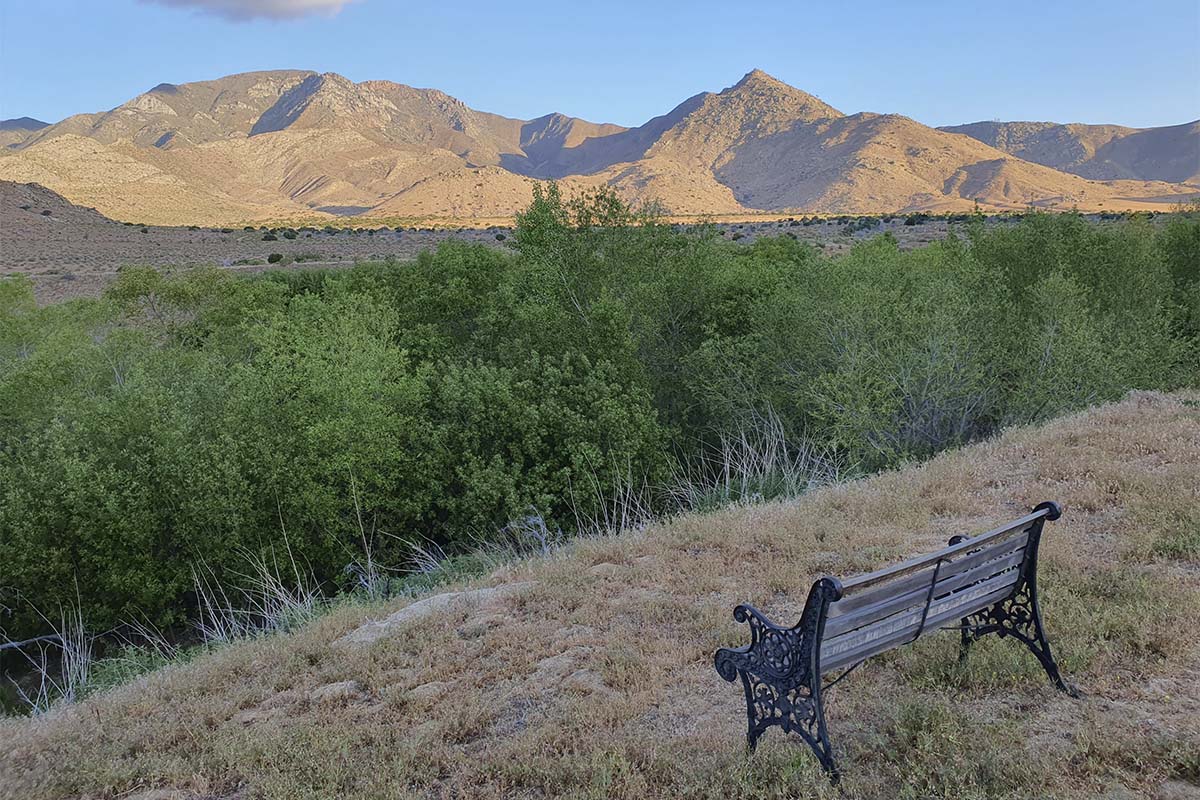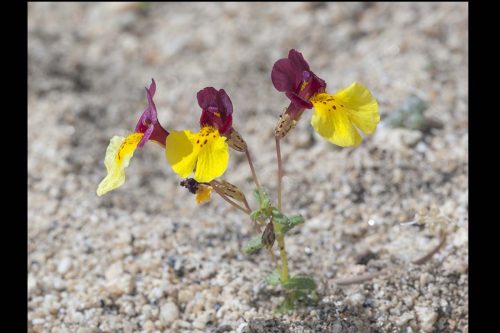
— Monkey Flower Ranch
You have 90 acres of our private land to explore: magnificent rocky hills, a year round creek, ninety acres of quiet, near-pristine land. There is a rich history of this land. The first people settled here nearly 6000 years ago – the Tübatulabal and Kawaiisu tribes raised families and lived in small settlements here thousands of years before the first European Americans seeped in. They lived, loved, fought, hunted, worshiped, sang, danced, and died – all here. This is what lingers in the atmosphere on the Monkey Flower Ranch, and it feels good. These folks may be gone now – but at one time they lived on this amazing piece of land.


And then came the ranchers and farmers who came to Weldon in the 1850s. There are remnants from early ranchers scattered about on the property.
But the strongest force out here is Mother Nature who reminds us each year that she is running the show out here. And what a show it is! We try to keep is as pristine as possible (no off road vehicles – motocross bikes, hunting etc.), but as long as we are here, there will always be a sharing process – give and take. The most important rule here is “leave no trace” while hiking around.
We have a unique ecosystem here. Our year long running creek comes from an underground river that surfaces a mile or so south of us running north to Weldon. This constant moisture provides a habitat that is difficult to find in the southern tip of the Sequoia national forest. In the Spring, the desert flowers blanket the property with a myriad of colors – the surronding mountains swathed in light brushes of purple, reds, and orange. In the winter, we get a light coat of snow. The flora and fauna thrive here.
Here’s a bit of local history: The Tübatulabal are the indigenous people native to the Kern River Valley, and to the Monkey Flower Ranch. Tübatulabal means “pine-nut eaters,” given to them by neighboring Yokuts. They separated from the Shoshone around 3,000 years ago and are divided into three bands: Bankalachi, Pahkanapil, and Palagewan.
Their traditional territory covered about 1,300 square miles, ranging from the high mountains surrounding us to the connected valleys like ours. Tübatulabal culture centered on gathering acorns and piñon nuts, hunting, and serving as important trade intermediaries between various neighboring groups. The Tübatulabal were known for their red pottery and coiled baskets, many of which you can see at the Kernville museum (highly recommended).
Unlike many other tribes, Tübatulabal women had equal voice in decisions – marriage required mutual consent.
The tribe suffered significant historical trauma, particularly during the Keyesville massacre of 1863, which nearly decimated them by killing most of their adult men. It was the men who were the story tellers, the farmers, the readers of the stars – their culture was nearly wiped out.
We have books on site that details their lives and history – but as I mentioned, I highly recommend the Kernville Museum in Kernville.

The Monkey Flower Ranch is named after the rare Monkeyflower (Mimulus shevockii) which is only found in our valley around Keslo Creek, Joshua Tree, and parts of Death Valley. It is an extremely rare and endangered flower so PLEASE take care not to harm it if you come across one. If you happen to spot one, please let me know where and when so that we can record these findings.
Loads of folks have not a clue about the vibrant and awe inspiring desert flowers that appear in the Spring. It all depends on how much rain we get during the winter months, but you can bet they will be blooming from March to May. Your best way to check beforehand is with the State Park websites that will give a good idea when to visit.
Besides the desert flowers, there are many species of high desert flora like sage, buckwheat, etc. most of which was used by the natives for cooking, teas, spiritual and medicinal uses.
Southern Sequoia bird watching is an amazing hobby. Many folks come out here to bird watch. Amongst the scores of birds here are my personal favorite: the Californian Raven. We have many flying over the property at any time of year. These majestic birds mate for life – and if you’re lucky enough, you can watch them tend to their young. Of the scores of high desert bird species, we have California Quail, Red-tailed Hawks, Western Bluebirds, Great Horned Owls, Nuttall’s Woodpeckers, Greater Roadrunners, and the occasional Golden Eagle. On landed in the tress just south of the house – it was HUGE. I was too slow with the camera though.
The best time for bird watching is during the early to late Spring and in the fall. You can find a full list of the birds spotted on the property and adjacent BLM land here: Bird list of Kelso Valley rd. and Rocky Point . Rocky point is the BLM land which is across the road from us.
You can consider the 90 acres of the Monkey Flower Ranch as a private ranch bird sanctuary.
The wildlife on our property and the surrounding area is quite diverse. This is the high desert where animals that are prevalent in higher elevations of the Sierra’s venture down to look for whatever they re looking for. Here are some of the animals you might see here.
Please use caution and discretion whenever encountering these animals (except for maybe the rodents). It is always good practice to remind oneself on what to do in case one encounters a bear or mountain lion. They have been spotted on the property more than once. Here are some good tips on what to do if you encounter a mountain lion
And this is what you do if you encounter a black bear at the ranch: Black Bears in California
Q: Can black bears climb trees faster than they can run?
A: Yes, black bears can generally climb trees faster than they can run. While they can run up to 30 mph, they can climb 100 feet up a tree in about 30 seconds. Their strong claws and limbs allow them to quickly and efficiently climb trees, even while they are heavy- black bears can climb trees faster than they can run – which is 35 mph.
There are small critters as well that you should be aware of:
Please be cautious picking up any logs or pieces of wood outdoors. Watch where you place your hands. The scorpions seem to come out at night and can be found using ultraviolet flashlights, which is really quite entertaining.